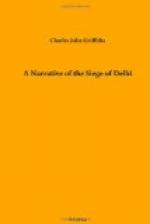The heat was insupportable, the thermometer under the shade of my tent marking 112 deg.F.; and to add to our misery there came upon us a plague of flies, the like of which I verily believe had not been on the earth since Moses in that manner brought down the wrath of God on the Egyptians. They literally darkened the air, descending in myriads and covering everything in our midst. Foul and loathsome they were, and we knew that they owed their existence to, and fattened on, the putrid corpses of dead men and animals which lay rotting and unburied in every direction. The air was tainted with corruption, and the heat was intense. Can it, then, be wondered that pestilence increased daily in the camp, claiming its victims from every regiment, native as well as European?
About this time many spies were captured and executed; in fact, so many prisoners were taken by the pickets that it was ordered that for the future, instead of being sent under escort to the camp for trial, they should be summarily dealt with by the officers commanding pickets.
On the evening of July 2 I was sent, in command of fifty men, to relieve the picket at a place called the “Cow House”; this was an outshed belonging to Sir Theophilus Metcalfe’s mansion, burnt by the rebels on May 11, and midway between that building and the stables, at each of which were stationed 150 men. At the beginning of the siege our left advanced flank, on the side of the River Jumna, was exposed to constant attacks by the enemy, and the three pickets mentioned above had been since that time stationed at those places. Each communicated with the other, the one to the right being on a mound near the ruins of the house, and some 1,200 yards from the city, the cowshed situated midway between this mound and the river, and, lastly, the stables close to the banks, all partially hidden from view of the batteries on the walls by gardens and thick clusters of trees.
I stationed my men at the sheds, and placed double rows of sentries to my front along the edge of a deep nallah, or ravine.
Soon after this that gallant officer, Lieutenant Hodson (on whose memory lately aspersions have been cast by an author who knows nothing of the subject on which he has written), rode up to the picket and told me that a sortie in force was expected that night, and that I was to keep a sharp lookout to prevent surprise.
Hodson, besides commanding a regiment of native Sikh cavalry of his own raising, was head of the Intelligence Department. He covered himself with glory during the siege, was untiring in his exertions and well-nigh ubiquitous, riding incessantly round the pickets at night, and being present at most of the engagements. He was a perfect Hindustani scholar, and it was reported in camp, though with what truth I cannot say, that he on several occasions entered Delhi in disguise during the siege to gain information of the enemy’s intentions. This may have been exaggeration, but it is nevertheless certain that, through some source or other, he made himself well acquainted with the doings and movements of the mutineers.




